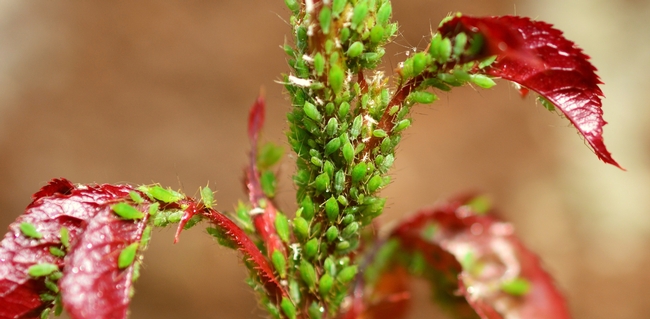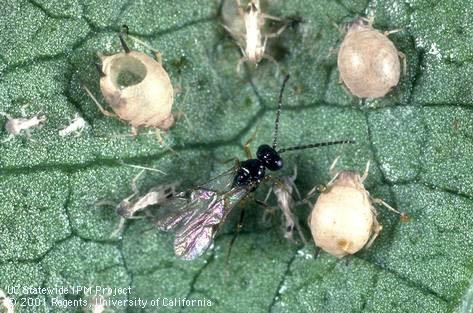- Author: Ed Perry
Aphids are a common garden pest in spring and are attracted to new, succulent plant growth. This year, heavy aphid infestations can already be found on roses and fruit trees.
Aphids often first show up along the edges of the garden. Many species infest the undersides of leaves first, so turn leaves over while looking for aphids. On some plant species, especially plum and apple trees, aphid feeding causes the leaves to curl. Once this happens, it's harder to obtain control because the curled leaves protect the pests from natural enemies or sprays.

When you find aphids, check for evidence of natural enemies like lady beetles, lacewings, syrphid fly larvae, and the mummified skins of parasitized aphids. Learn to recognize aphid “mummies,” as they indicate the presence of tiny parasitic wasps that lay eggs inside the aphids. The wasp larva hatches and feeds inside the aphid, killing it. The skin of dead aphids turns crusty and golden brown or black, a form called a mummy. Not long after, the adult wasp chews an exit hole and emerges from the aphid's body. During warm weather, parasitic wasps may have several generations and cause a rapid decline in aphid populations.
There are fungus diseases that infect aphids, especially when it's warm and humid. Entire populations of aphids may be killed when conditions are right. While aphids thrive under mild temperatures, populations of many species are reduced by hot summer weather conditions. If you have any of these natural controls at work, the aphid population may crash rapidly.

You may be able to control aphids in your trees by controlling ants. If large numbers of ants are seen climbing up and down tree trunks, it may mean an aphid infestation. Ants are attracted to the honeydew produced by the aphids. If you plan to use pesticides for ant control, first seek out and treat the ants' nests in the ground near the tree. Or, place sticky barriers around the tree trunk to keep the ants from reaching the aphids. Unprotected by the ants, the aphids may then be attacked by natural enemies.
You can help prevent aphid infestations, especially in vegetables, by removing weeds where aphids may be building up. Also, check transplants for aphids and remove them before planting. If you notice a few curled leaves on your fruit trees, the best control may be to simply prune out and dispose of the infested shoots and leaves.

